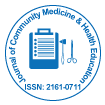当社グループは 3,000 以上の世界的なカンファレンスシリーズ 米国、ヨーロッパ、世界中で毎年イベントが開催されます。 1,000 のより科学的な学会からの支援を受けたアジア および 700 以上の オープン アクセスを発行ジャーナルには 50,000 人以上の著名人が掲載されており、科学者が編集委員として名高い
。オープンアクセスジャーナルはより多くの読者と引用を獲得
700 ジャーナル と 15,000,000 人の読者 各ジャーナルは 25,000 人以上の読者を獲得
インデックス付き
- 索引コペルニクス
- Google スカラー
- シェルパ・ロミオ
- Genamics JournalSeek
- セーフティライト付き
- レフシーク
- ハムダード大学
- エブスコ アリゾナ州
- OCLC-WorldCat
- パブロン
- ジュネーブ医学教育研究財団
- ユーロパブ
- ICMJE
役立つリンク
オープンアクセスジャーナル
このページをシェアする
抽象的な
Ten-Year Coronary Artery Disease Risk in 1571 Newly Presenting Hypertensive Black Subjects
Ojji D, Stewart S, Atherton J, Ajayi S, Mamven M, Ngabea M, Ojji O and Sliwa Karen
Background: Although hypertension is highly prevalent in Nigeria, coronary artery disease (CAD) remains relatively uncommon. This may well change due to epidemiological transition. To ascertain the future role of CAD in Nigeria, we risk stratified every consecutive hypertensive subject referred to the Cardiology unit of the University of Abuja Teaching Hospital over 7 years.
Hypothesis: A significant proportion of the study population will fall within the intermediate or high risk category.
Methods: It is a prospective, observational study. 1571 hypertensive subjects were risk stratified according to the Framingham 10-year Risk Score.
Results: 834(53.1%) of the subjects were female while 737(46.9%) were male. The mean age, mean body mass index and mean arterial pressure of the subjects were 50.9 ± 11.4 years, 28.1 ± 9.4 kg/m2 and 116.23 ± 13.1 mmHg respectively. According to Framingham criteria, 1263(80.4%) of the study population were low risk individuals, 286(18.2%) were medium risk, 22(1.4%) were high risk individuals. When the age of the subjects was hypothetically increased by an additional 10 years, the high risk group increased from 1.3% to 21.3%.
Conclusions: According to the Framingham risk score, the majority of subjects with hypertension presenting to a large teaching hospital in Nigeria have a low risk of developing CAD in the near future, which contrasts with the risk profile seen in hypertensive subjects in Europe and North America. Nonetheless, approximately one in four subjects were classified as intermediate or high risk emphasizing the importance of lifestyle modification and the need to consider absolute risk stratification to guide management in countries undergoing epidemiological transition.

 English
English  Spanish
Spanish  Chinese
Chinese  Russian
Russian  German
German  French
French  Portuguese
Portuguese  Hindi
Hindi